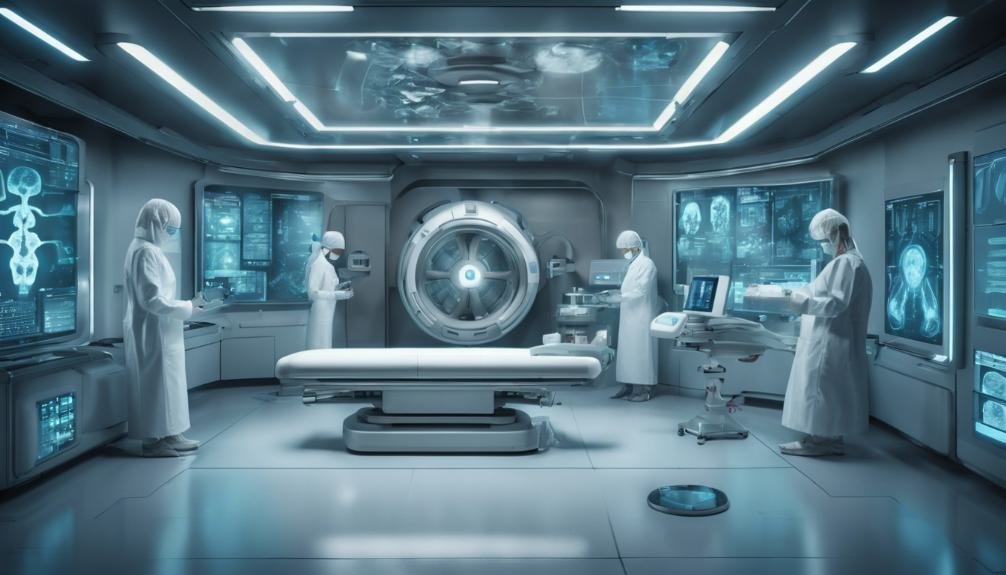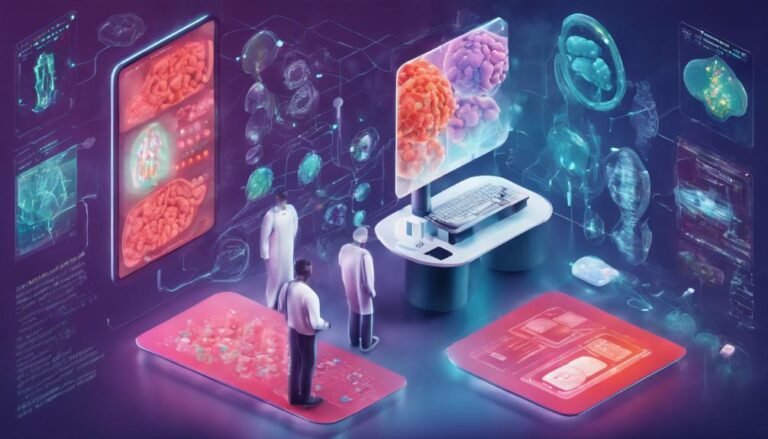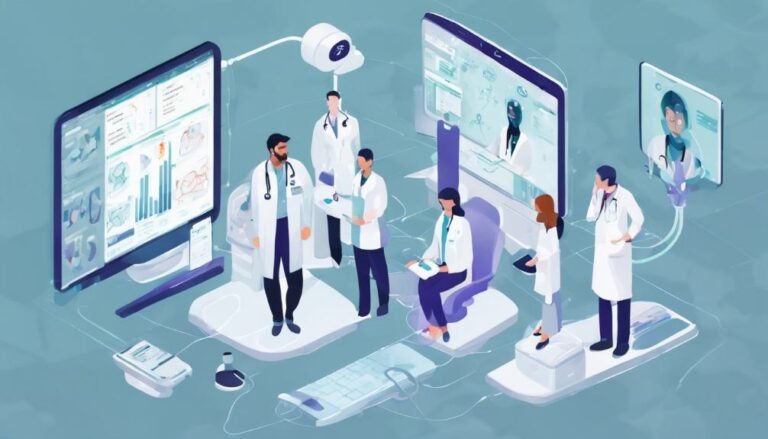AI in Nuclear Medicine
In the domain of nuclear medicine, the integration of AI has sparked notable advancements in diagnostic capabilities and patient care processes. Imagine a scenario where complex imaging data is deciphered with unparalleled accuracy, uncovering subtle disease indicators that might have otherwise gone unnoticed. This transformative technology not only holds the potential to enhance individualized treatment plans but also to optimize resource allocation and bolster disease identification. The possibilities that AI offers in nuclear medicine are vast and could pave the way for a new era of precision healthcare delivery, reshaping the landscape of medical practice as it stands.
Key Takeaways
- AI in nuclear medicine enhances diagnostic accuracy by analyzing imaging data with precision.
- Personalized treatment plans are developed based on patient-specific data analyzed by AI.
- AI improves disease detection by detecting subtle signs at early stages.
- Streamlined patient care through AI's remote monitoring and predictive analytics.
- AI advances imaging techniques, automates interpretation, and optimizes patient outcomes.
Enhancing Diagnostic Accuracy
By harnessing the power of artificial intelligence (AI), nuclear medicine is greatly enhancing diagnostic accuracy in medical imaging processes. AI algorithms are revolutionizing the field by enabling early detection of abnormalities that may have been overlooked by traditional methods.
Through advanced image analysis, AI can detect subtle signs of disease at the earliest stages, allowing for prompt intervention and treatment optimization.
AI algorithms in nuclear medicine play a vital role in identifying minute changes in cellular activity that could signify the presence of a disease. This early detection capability is instrumental in catching conditions such as cancer in their nascent stages, when treatment can be most effective.
By providing precise and detailed analyses of medical images, AI assists healthcare professionals in developing personalized treatment plans tailored to each patient's unique needs.
The integration of AI in nuclear medicine not only enhances diagnostic accuracy but also contributes to improving patient outcomes by facilitating early detection and treatment optimization.
As technology continues to advance, the impact of AI on medical imaging processes is expected to grow exponentially, further revolutionizing the field of nuclear medicine.
Personalizing Treatment Plans
Personalizing treatment plans in nuclear medicine involves tailoring interventions based on individual patient characteristics and medical imaging data. Through the use of AI technologies, treatment optimization is achievable by analyzing vast amounts of patient-specific data to determine the most effective course of action. By implementing tailored therapies, medical advancements in nuclear medicine can greatly enhance patient outcomes.
AI plays an essential role in personalizing treatment plans by assisting in the interpretation of complex imaging results and predicting response to specific treatments. This allows healthcare providers to customize interventions, such as radiation therapy or targeted radionuclide therapies, to suit each patient's unique needs.
Improving Disease Detection
AI in nuclear medicine has the potential to greatly enhance diagnostic accuracy by analyzing complex imaging data with unprecedented detail.
By leveraging machine learning algorithms, medical professionals can streamline patient care processes, leading to faster detection and treatment of diseases.
This integration of AI technologies in disease detection is poised to revolutionize nuclear medicine practices, optimizing patient outcomes and resource utilization.
Enhanced Diagnostic Accuracy
Improving disease detection through enhanced diagnostic accuracy in nuclear medicine involves utilizing AI algorithms to analyze medical imaging data with heightened precision and sensitivity. AI algorithms play an essential role in identifying subtle patterns and anomalies within imaging scans that are often imperceptible to the human eye.
By leveraging advanced machine learning techniques, these algorithms can detect minute changes indicative of various diseases, such as cancer or neurological disorders, at earlier stages.
The diagnostic precision achieved through AI-driven analysis enhances the accuracy of disease detection, leading to improved patient outcomes and more tailored treatment plans. AI algorithms excel in recognizing intricate relationships within imaging data, allowing for thorough assessments that aid in the early detection and monitoring of diseases.
Additionally, the continuous learning capabilities of AI systems enable them to adapt and refine their diagnostic capabilities over time, further enhancing their accuracy and reliability in nuclear medicine applications.
Streamlined Patient Care
Enhancing disease detection through streamlined patient care involves implementing efficient processes and technologies to optimize diagnostic accuracy in nuclear medicine.
Remote monitoring plays a pivotal role in this streamlined approach, allowing healthcare providers to track patients' progress and response to treatment from a distance. By utilizing remote monitoring devices, such as wearable sensors or mobile apps, real-time data can be collected and analyzed, aiding in the early detection of any abnormalities.
Predictive analytics further enhance disease detection by utilizing algorithms to identify patterns and trends in patient data, helping to predict potential health issues before they manifest. These advanced analytical tools can assist healthcare professionals in making informed decisions regarding patient care, leading to more accurate diagnoses and personalized treatment plans.
Advancing Imaging Techniques
You can now explore the world of advancing imaging techniques in nuclear medicine, where AI-enhanced image analysis plays a pivotal role.
Through the integration of artificial intelligence, diagnostic accuracy is greatly improved, allowing for more precise and reliable detection of diseases.
These advancements in imaging techniques are revolutionizing the field, enhancing patient care and treatment outcomes.
Ai-Enhanced Image Analysis
Utilizing artificial intelligence (AI) in nuclear medicine has revolutionized image analysis by enhancing the thorough and markedly improving the efficiency of imaging techniques. AI-driven machine learning algorithms have greatly advanced automated interpretation of nuclear imaging studies. These algorithms can quickly analyze vast amounts of imaging data, identifying patterns and anomalies with notable accuracy.
One key area where AI-enhanced image analysis excels is in the detection of subtle changes that may be indicative of early disease progression. By training on large datasets, AI systems can learn to recognize minute differences in images that might escape the human eye. This capability enables healthcare professionals to make more informed decisions based on detailed and precise image assessments.
Moreover, AI algorithms can aid in standardizing image interpretation across different radiologists, reducing variability in diagnoses. By providing objective insights based on quantitative data, AI contributes to enhancing the overall quality and consistency of nuclear medicine imaging evaluations.
This technology holds great promise for streamlining workflows and improving patient care in the field of nuclear medicine.
Improved Diagnostic Accuracy
AI in nuclear medicine has greatly enhanced diagnostic accuracy by leveraging cutting-edge imaging techniques. Through AI-driven interpretations and machine learning applications, the field has witnessed a significant boost in diagnostic precision, ultimately leading to improved patient outcomes.
Machine learning algorithms embedded within nuclear imaging systems can analyze vast amounts of data with incredible speed and accuracy. These algorithms can detect subtle patterns and anomalies in images that may not be easily discernible to the human eye.
By providing quantitative measurements and automated image analysis, AI assists in identifying abnormalities, tracking disease progression, and predicting treatment responses more effectively.
Moreover, AI can assist in optimizing imaging parameters, enhancing image quality, and reducing artifacts, thereby improving the overall reliability of diagnostic tests. With the ability to learn from vast datasets and adapt to new information, AI continues to revolutionize nuclear medicine by pushing the boundaries of diagnostic accuracy and ultimately benefiting patient care.
Speeding Up Data Analysis
Improving the efficiency of data analysis processes is an essential aspect of integrating artificial intelligence (AI) into nuclear medicine. In this regard, AI plays a pivotal role in speeding up data analysis by providing real-time insights and enabling automated reporting mechanisms. Through the use of AI algorithms, vast amounts of imaging data can be processed rapidly and accurately, allowing for quick identification of patterns, anomalies, and potential areas of concern.
AI systems can analyze images, such as PET scans or SPECT images, in a fraction of the time it would take a human expert, leading to quicker decision-making processes. By automating reporting tasks, AI reduces the burden on healthcare professionals, enabling them to focus more on patient care and treatment planning. Additionally, AI can assist in flagging urgent cases for immediate attention, ensuring timely interventions when necessary.
In nuclear medicine, the speed and accuracy of data analysis are critical for providing high-quality care to patients. AI-driven solutions offer a pathway to enhance efficiency, improve diagnostic accuracy, and ultimately elevate the standard of healthcare delivery in nuclear medicine.
Precision in Healthcare Delivery
To maximize the impact of AI in nuclear medicine, achieving precision in healthcare delivery is essential for optimizing patient outcomes and treatment efficacy. Utilizing AI for data interpretation in nuclear medicine allows for more accurate diagnosis and personalized treatment plans. By analyzing vast amounts of patient data, AI can assist in identifying patterns and trends that may not be easily discernible through traditional methods.
This enhanced data interpretation capability enables healthcare providers to make more informed decisions regarding patient care.
Moreover, AI plays an important role in treatment optimization by helping healthcare professionals tailor therapies to individual patients. Through machine learning algorithms, AI can analyze patient responses to different treatments and predict the most effective course of action. This personalized approach enhances treatment outcomes and reduces the likelihood of adverse reactions.
Future of AI Integration
In the upcoming advancements of nuclear medicine, the seamless integration of artificial intelligence promises to revolutionize diagnostic accuracy and treatment customization. AI integration impacts the field by enhancing image analysis, enabling earlier disease detection, and facilitating personalized treatment strategies.
Innovative technology advancements in AI algorithms allow for the processing of vast amounts of imaging data with unprecedented speed and accuracy, leading to more precise diagnosis and treatment planning.
Furthermore, AI integration in nuclear medicine paves the way for predictive modeling, where machine learning algorithms can forecast patient outcomes based on individual characteristics and treatment responses. This predictive capability enables healthcare providers to proactively adjust treatment regimens for better patient outcomes.
Conclusion
As you journey into the domain of nuclear medicine, remember that AI is the compass guiding you through the intricate maze of data and images.
Like a skilled navigator, AI enhances diagnostic accuracy, personalizes treatment plans, and advances imaging techniques with precision and efficiency.
Embrace the future of AI integration in nuclear medicine, where innovation and technology converge to revolutionize patient care and improve healthcare outcomes.
The possibilities are endless, and the benefits are infinite.







